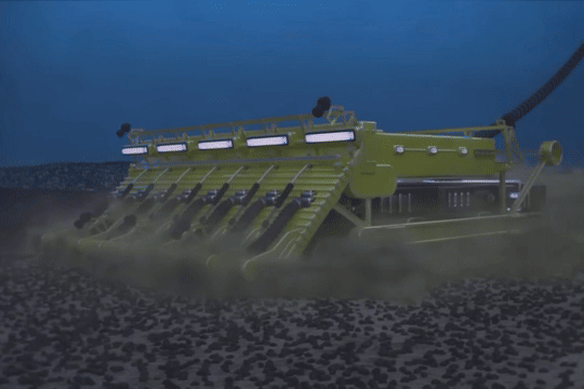By Angus Dalton
In the pitch-dark wilderness of the deep sea, which hosts a trove of translucent creatures and billions of tonnes of critical metals, something extraordinary is happening: oxygen is spawning in the absence of light.
That’s the conclusion of scientists who have reported nodules of metallic rock on the sea floor are generating their own voltage and splitting water into hydrogen and so-called “dark oxygen”.

Polymetallic nodules cover vast tracts of the sea floor and contain metals critical for electric vehicles – and they may also be producing oxygen.Credit: NOAA
The finding could impact the plans of mining companies to harvest these metal-rich nodules, and the discovery also challenges theories about how life arose on Earth and where it might exist on other planets.
“Our understanding has been that Earth’s oxygen supply began with photosynthetic organisms,” lead author of the Nature Geoscience research, Professor Andrew Sweetman, said. “But we now know that there is oxygen produced in the deep sea, where there is no light. I think we therefore need to revisit questions like: where could aerobic life have begun?”
Vast abyssal plains on the ocean floor are dotted with these dark potato-like lumps, called polymetallic nodules, which hold trillions of dollars worth of cobalt, nickel, manganese and other metals critical for lithium-ion batteries and electric vehicles.

An animation showing how a prospective deep-sea mining vehicle could be deployed to harvest vast tracts of metal-rich polymetallic nodules.Credit: MIT Mechanical Engineering
Sweetman and his colleagues have been studying the Clarion-Clipperton Zone, an area of the Pacific Ocean between Hawaii and Mexico slated for deep-sea mining. They lowered chambers over nodules more the 4000 metres deep. Instead of oxygen decreasing in the chambers, as expected, over two days the levels steadily grew.
The scientists cross-checked their readings, ruled out faulty equipment and tested multiple sites. Oxygen levels kept increasing.
That’s when Sweetman knew they were on to something “groundbreaking and unthought of”.
The scientists found the nodules can generate enough electricity to split water into hydrogen and oxygen, a process called electrolysis.
“At this stage we don’t know how the nodules produce the voltage,” Sweetman, who’s from the Scottish Association for Marine Science, said. “But it’s possible that the necessary energy comes from the potential difference between metal ions within the nodule layers, leading to an internal redistribution of electrons.”
The research was funded by The Metals Company, one of the outfits in the race to mine the deep sea. The company calls the nodules “batteries in a rock” and claims there’s enough critical metals in the Pacific Ocean to electrify 280 million electric vehicles.

A new and strange species discovered living near the nodules of the Clarion-Clipperton Zone.Credit: Craig Smith and Diva Amon, ABYSSLINE Project.
But hundreds of scientists and several countries have called for a halt to deep-sea mining until we understand how exploiting the sea floor could impact ocean ecology and the carbon cycle.
The dark oxygen discovery has added yet more mystery to the deep sea and also sheds new light on how aerobic life may arise on bodies such as Enceladus and Europa, moons of Jupiter believed to host vast oceans.
“We’ve typically centred the search for life beyond Earth around microbes using reduced chemicals for energy,” said Jeffrey Marlow, a professor of biology at Boston University and the paper’s co-author. “It might be wise to expand our perspective.”
The Examine newsletter explains and analyses science with a rigorous focus on the evidence. Sign up to get it each week.